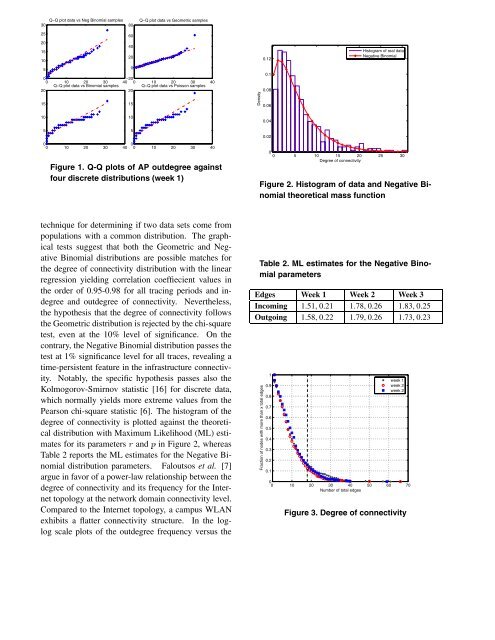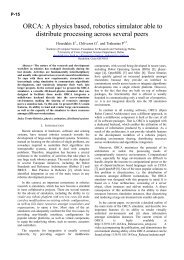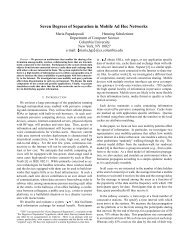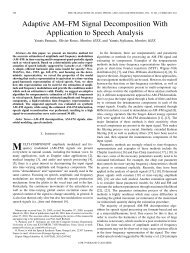Modeling Roaming in Large-scale Wireless Networks using Real ...
Modeling Roaming in Large-scale Wireless Networks using Real ...
Modeling Roaming in Large-scale Wireless Networks using Real ...
Create successful ePaper yourself
Turn your PDF publications into a flip-book with our unique Google optimized e-Paper software.
30<br />
Q−Q plot data vs Neg B<strong>in</strong>omial samples<br />
80<br />
Q−Q plot data vs Geometric samples<br />
25<br />
60<br />
20<br />
40<br />
15<br />
20<br />
10<br />
5<br />
0<br />
0<br />
−20<br />
0 10 20 30 40 0 10 20 30 40<br />
Q−Q plot data vs B<strong>in</strong>omial samples<br />
Q−Q plot data vs Poisson samples<br />
20<br />
20<br />
15<br />
15<br />
Density<br />
0.12<br />
0.1<br />
0.08<br />
0.06<br />
Histogram of real data<br />
Negative B<strong>in</strong>omial<br />
10<br />
10<br />
0.04<br />
5<br />
0<br />
0 10 20 30 40<br />
5<br />
0<br />
0 10 20 30 40<br />
Figure 1. Q-Q plots of AP outdegree aga<strong>in</strong>st<br />
four discrete distributions (week 1)<br />
0.02<br />
0<br />
0 5 10 15 20 25 30<br />
Degree of connectivity<br />
Figure 2. Histogram of data and Negative B<strong>in</strong>omial<br />
theoretical mass function<br />
technique for determ<strong>in</strong><strong>in</strong>g if two data sets come from<br />
populations with a common distribution. The graphical<br />
tests suggest that both the Geometric and Negative<br />
B<strong>in</strong>omial distributions are possible matches for<br />
the degree of connectivity distribution with the l<strong>in</strong>ear<br />
regression yield<strong>in</strong>g correlation coeffiecient values <strong>in</strong><br />
the order of 0.95-0.98 for all trac<strong>in</strong>g periods and <strong>in</strong>degree<br />
and outdegree of connectivity. Nevertheless,<br />
the hypothesis that the degree of connectivity follows<br />
the Geometric distribution is rejected by the chi-square<br />
test, even at the 10% level of significance. On the<br />
contrary, the Negative B<strong>in</strong>omial distribution passes the<br />
test at 1% significance level for all traces, reveal<strong>in</strong>g a<br />
time-persistent feature <strong>in</strong> the <strong>in</strong>frastructure connectivity.<br />
Notably, the specific hypothesis passes also the<br />
Kolmogorov-Smirnov statistic [16] for discrete data,<br />
which normally yields more extreme values from the<br />
Pearson chi-square statistic [6]. The histogram of the<br />
degree of connectivity is plotted aga<strong>in</strong>st the theoretical<br />
distribution with Maximum Likelihood (ML) estimates<br />
for its parameters r and p <strong>in</strong> Figure 2, whereas<br />
Table 2 reports the ML estimates for the Negative B<strong>in</strong>omial<br />
distribution parameters. Faloutsos et al. [7]<br />
argue <strong>in</strong> favor of a power-law relationship between the<br />
degree of connectivity and its frequency for the Internet<br />
topology at the network doma<strong>in</strong> connectivity level.<br />
Compared to the Internet topology, a campus WLAN<br />
exhibits a flatter connectivity structure. In the loglog<br />
<strong>scale</strong> plots of the outdegree frequency versus the<br />
Table 2. ML estimates for the Negative B<strong>in</strong>omial<br />
parameters<br />
Edges Week 1 Week 2 Week 3<br />
Incom<strong>in</strong>g 1.51, 0.21 1.78, 0.26 1.83, 0.25<br />
Outgo<strong>in</strong>g 1.58, 0.22 1.79, 0.26 1.73, 0.23<br />
Fraction of nodes with more than x total edges<br />
1<br />
0.9<br />
0.8<br />
0.7<br />
0.6<br />
0.5<br />
0.4<br />
0.3<br />
0.2<br />
0.1<br />
week 1<br />
week 2<br />
week 2<br />
0<br />
0 10 20 30 40 50 60 70<br />
Number of total edges<br />
Figure 3. Degree of connectivity
















